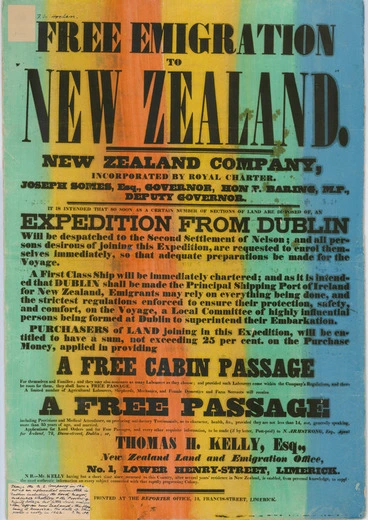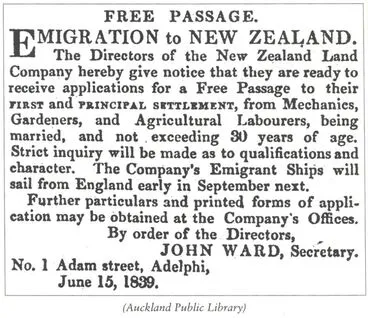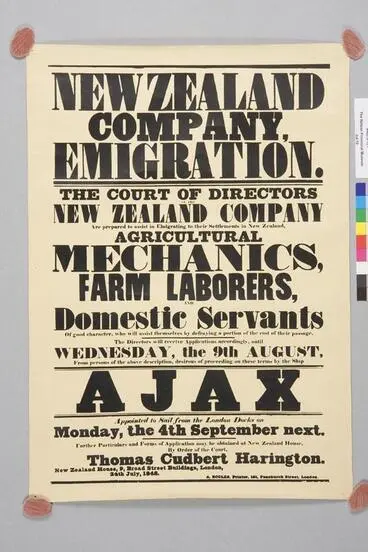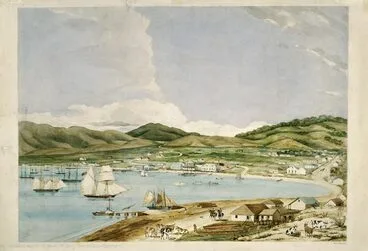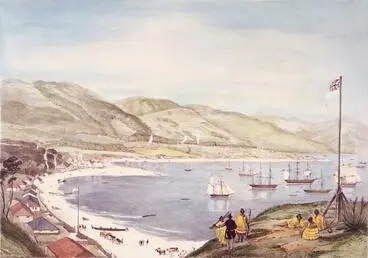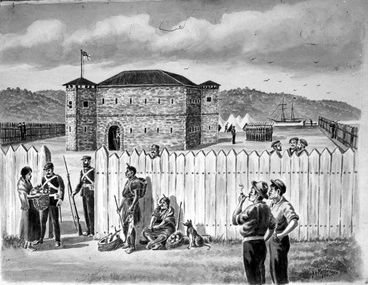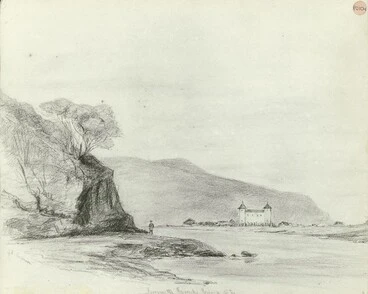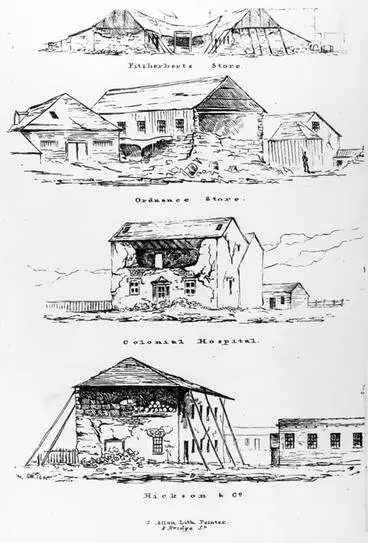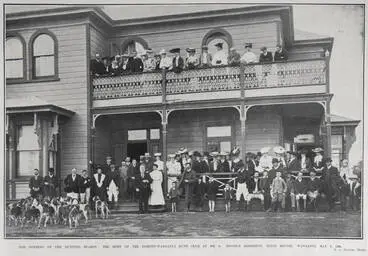"ELIZA to LORNA" - The Higgie Clan - Part 1 - Wellington
A DigitalNZ Story by Dan
My great great great grandparents Thomas & Mary Higgie arrived in New Zealand in 1841. This Story is about their first 8 years in Wellington and is taken from the first few paragraphs of a book written by my grandmother Lorna Cameron (née Higgie).
Part 1
Thomas Alexander Higgie, my great-grandfather, was born in Cuper, Fife, in Scotland in the year 1817. He was a carpenter by trade, in the ship building industry, when he married Mary Clark at Dundee in 1840. The future for this young couple could not have been promising to make them respond to a document from "The New Zealand Company" inviting folk to emigrate to a colonial settlement being established in New Zealand, far away in the South Pacific Ocean.
Free emigration to New Zealand poster
University of Otago
Emigration Free Passage Notice
Kete Horowhenua
A big decision indeed, to embark on such a long voyage, over many thousands of miles of treacherous oceans – but Thomas and Mary, who was now pregnant with their first child, decided this was to be their future life.
They left Scotland on December 9th 1840, on the “S.S. Olympus” and after a lengthy journey arrived at Port Nicholson, Wellington Harbour on 20th May 1841, with their son Thomas Jnr., having been born, on ship, on 26th January, 1841.
Wellington, 1841
Manatū Taonga, the Ministry for Culture and Heritage
Charles Heaphy, 'Part of Lambton Harbour'
Manatū Taonga, the Ministry for Culture and Heritage
Wellington Harbour, N.Z.
Museum of New Zealand Te Papa Tongarewa
Thomas Higgie, only 24 years of age at this time, must have been a very innovative young man as shortly after his arrival he and a friend cleared land out in the, near by, Hutt Valley where they planted a crop of wheat. When sometime later, they heard that hostile Maori’s were on their way to raid the Hutt area they quickly organised a boat to take them over the harbour, and I feel sure, there would then be quite a long walk to their wheat field. They must surely have recruited some help on the way, for after threshing all night, they returned, with their wheat, to Wellington! From an article in a Wanganui newspaper I have been able to learn a little of Thomas and Mary’s first few years in New Zealand. (This article was prepared from J.G.Woon’s book – “Wanganui’s old Settlers” published in 1902.)
Wanganui Old Settlers - The Pamphlet Collection of Sir Robert Stout: Volume 76
Victoria University of Wellington
A very satisfying nights work, to say the least, and an indication of what this hardworking young man would be achieving in the years ahead. After the incident in the Hutt Valley, Thomas built the Wellington Blockhouse for safety of settlers against the unfriendly natives who were attacking the Europeans.
In about 1844, while Thomas was away building a mill for the Manawatu settlement, a big fire occurred in Wellington and Mary Higgie, and by then her two children (Thomas and Mary), narrowly escaped and spent the night sheltering under a boat.
Paremata barracks
Manatū Taonga, the Ministry for Culture and Heritage
FIRES. (New Zealand Gazette and Wellington Spectator, 10 January 1844)
National Library of New Zealand
PREVIOUS BIG FIRES. (Evening Post, 22 October 1906)
National Library of New Zealand
Thomas then built the Porirua Blockhouse, this time a stone structure. However, another calamity occurred that must have challenged the Higgie family’s decision to make a new life for themselves on the far side of the Planet.
Paremata Barracks, Porirua, 1846
Manatū Taonga, the Ministry for Culture and Heritage
Gold, Charles Emilius 1809-1871 :Porirua N. Zealand 1858
Alexander Turnbull Library
The very strong earthquake that hit the Wellington region in 1848 almost demolished the entire Porirua Village, and the Blockhouse was damaged beyond repair. What a dreadful experience for these new settlers to have to contend with! Would they have known, or been forewarned of such events as earthquakes? Probably not!
Reporting the 1848 quake
Manatū Taonga, the Ministry for Culture and Heritage
Earthquake damage, Wellington, 1848
Manatū Taonga, the Ministry for Culture and Heritage
The Earthquake of 1848 - Early Wellington
Victoria University of Wellington
Perhaps the troubled times Thomas and Mary were having in their 8 years in the Wellington district made them decide to look further north to settle.
This Story is followed by:
